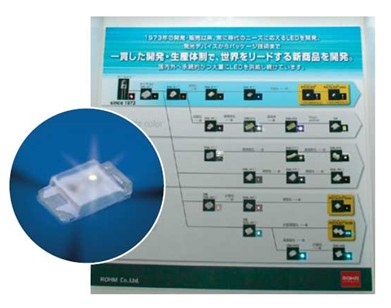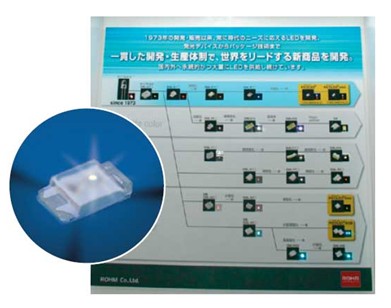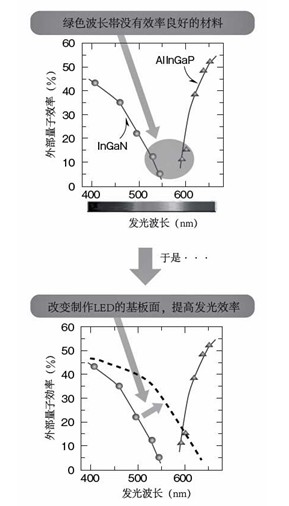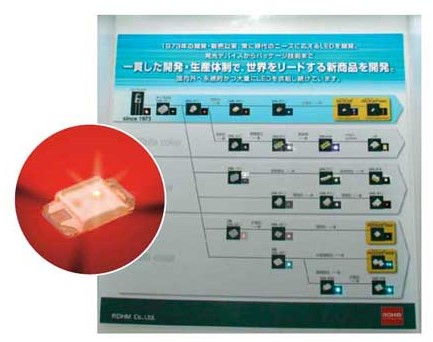LED basic knowledge of common LED introduction
Date:2018-08-09
Blue LED
Refers to the blue LED. The center of the emission wavelength is around 470 nm. A light source for a blue display portion such as a lighting fixture and an indicator, a blue light source for an LED display panel, and a backlight source of the liquid crystal panel. Use in combination with a phosphor material to obtain white light. Current white LEDs generally use a combination of blue LEDs and fluorescent materials.
The opportunity for the wide application of blue LEDs was the first time in 1993 that Nichia Chemical Industry developed a variety of light intensity of more than 1 cd. Prior to this, there were no LEDs with high blue purity and practical light intensity. Therefore, a large-size display using LEDs cannot achieve full-color display.
The material of the blue LED uses a gallium nitride (GaN)-based semiconductor. In the past, blue LEDs were developed using zinc selenide (ZnSe) semiconductors. However, since the development of high-brightness blue LEDs using GaN-based semiconductors in December 1993, the mainstream of blue LEDs has become GaN-based. Semiconductor products.
The illuminating scene of Roma's blue LED.
The blue LED is configured such that an aluminum nitride (AlN) semiconductor layer and a GaN-based semiconductor layer are stacked on a surface of a sapphire or SiC substrate or the like. A structure in which a p-type GaN-based semiconductor layer and an n-type GaN-based semiconductor layer are overlapped is provided in a portion called an active layer and blue-emitting light.
The pn junction is the structure that must be used to make high-brightness LEDs. Among LEDs such as red, which use materials other than GaN, the pn junction is a mainstream structure long ago. Before the introduction of high-brightness blue LEDs in 1993, it was difficult to achieve pn junctions using GaN-based materials. The reason is that the formation of the n-type GaN-based semiconductor layer is relatively simple, but the fabrication of the p-type GaN-based semiconductor layer is difficult. After that, by using a multiple quantum well structure for the GaN-based semiconductor layer disposed between the p-type GaN-based semiconductor layer and the n-type GaN-based semiconductor layer, and further improving the quality of the GaN-based semiconductor layer, the light intensity is greatly improved.
Blue LED
Refers to the blue LED. The center of the emission wavelength is around 470 nm. A light source for a blue display portion such as a lighting fixture and an indicator, a blue light source for an LED display panel, and a backlight source of the liquid crystal panel. Use in combination with a phosphor material to obtain white light. Current white LEDs generally use a combination of blue LEDs and fluorescent materials.
The opportunity for the wide application of blue LEDs was the first time in 1993 that Nichia Chemical Industry developed a variety of light intensity of more than 1 cd. Prior to this, there were no LEDs with high blue purity and practical light intensity. Therefore, a large-size display using LEDs cannot achieve full-color display.
The material of the blue LED uses a gallium nitride (GaN)-based semiconductor. In the past, blue LEDs were developed using zinc selenide (ZnSe) semiconductors. However, since the development of high-brightness blue LEDs using GaN-based semiconductors in December 1993, the mainstream of blue LEDs has become GaN-based. Semiconductor products.
The illuminating scene of Roma's blue LED.
The blue LED is configured such that an aluminum nitride (AlN) semiconductor layer and a GaN-based semiconductor layer are stacked on a surface of a sapphire or SiC substrate or the like. A structure in which a p-type GaN-based semiconductor layer and an n-type GaN-based semiconductor layer are overlapped is provided in a portion called an active layer and blue-emitting light.
The pn junction is the structure that must be used to make high-brightness LEDs. Among LEDs such as red, which use materials other than GaN, the pn junction is a mainstream structure long ago. Before the introduction of high-brightness blue LEDs in 1993, it was difficult to achieve pn junctions using GaN-based materials. The reason is that the formation of the n-type GaN-based semiconductor layer is relatively simple, but the fabrication of the p-type GaN-based semiconductor layer is difficult. After that, by using a multiple quantum well structure for the GaN-based semiconductor layer disposed between the p-type GaN-based semiconductor layer and the n-type GaN-based semiconductor layer, and further improving the quality of the GaN-based semiconductor layer, the light intensity is greatly improved.
Green LED
A diode that emits green light. The center wavelength of the luminescence is around 560 nm. Used for neon lights and indicators, light sources for LED displays, and backlight sources for liquid crystal panels.
Compared with red LEDs and blue LEDs, green LEDs are considered to have much room for improvement. When a combination of a red LED, a green LED, and a blue LED constitutes a backlight source of an LED display or a liquid crystal panel, in order to modulate a high-brightness and balanced white color, considering the visual sensitivity of the human eye, the distribution ratio of the RGB three-color LED light amount is required. It is about 3:6:1 or about 3:7:1. Because the brightness of the green LED is insufficient, multiple green LEDs must be used to increase the output power. The GaN-based semiconductor material mainly used for green LEDs is less efficient than that used for blue LEDs, and inputs the same power, and the optical output power is low.
This situation has begun to change. Universities and LED chip manufacturers in Japan and abroad have begun to study to significantly improve efficiency by changing the growth surface of GaN crystals. If the crystal face of the GaN-based semiconductor is changed, it is possible to increase the efficiency of the green LED by more than twice the current level.
The reason why the current GaN-based semiconductor green LEDs are inefficient is mainly due to the piezoelectric field. The piezoelectric field refers to an electric field generated by piezoelectric polarization due to stress of a crystal structure. A green LED which is commercially available is a laminated GaN-based semiconductor layer in which a polar surface c-plane (0001) of a GaN crystal is a growth surface, and a normal direction (c-axis) is a growth axis. The piezoelectric polarization is attenuated by changing the growth axis, and a non-polar surface called an a-plane or an m-plane perpendicular to the c-plane of the GaN-based crystal, or a semipolar plane inclined with respect to the c-plane is a growth plane, The study of the green LED with the normal direction of each face as the growth axis is very active.
Red LED
A diode that emits red light. The center wavelength of the luminescence is about 620 to 630 nm. It is mainly used for light sources in red display parts of neon lights, indicators, car taillights and signal machines, red light sources of LED displays, and backlight sources of liquid crystal panels, etc., and has a wide range of applications.
At present, the mainstream material of red LED is A lInGaP compound semiconductor. AlInGaP is called a quaternary material because it uses four elements of Al, Ga, In, and P. The 4-element material in the LED field generally refers to AlInGaP. More than just red, AlInGaP covers the wavelength range from red to yellow.
The brightness of AlInGaP increased rapidly after entering the 1990s. This is because the progress of the vapor phase epitaxial growth technique represented by the MOCVD method is improved, and the quality of the crystal is improved. Before the advent of AlInGaP, GaAs-based semiconductors were the mainstream material. The liquid phase epitaxial growth technique is employed.
Rom's red LED glow scene
Red LEDs have different drive voltage and temperature characteristics than blue and green LEDs. This is because the semiconductor materials are different, the red LEDs use AlInGaP, and the blue LEDs and green LEDs use GaN-based materials. In terms of driving voltage (forward voltage), the red LED is 2V or more, and the blue LED and the green LED are 3V or more. In terms of temperature characteristics, the output power of the red LED will change greatly due to the influence of temperature. The output power at high temperature is lower than that of the green LED and the blue LED. Due to the difference in these characteristics, when a combination of a backlight of a liquid crystal panel and an LED display uses a red LED, a blue LED, and a green LED, it is necessary to take corresponding measures. For example, using a color sensor to monitor changes in the characteristics of a red LED, it is also necessary to improve the heat dissipation performance of the LED.
* The external quantum efficiency of InGaN and AlInGaP at the green wavelength Large is greatly reduced.
Ultraviolet LED
A diode that emits ultraviolet light. Generally speaking, an LED having an emission center wavelength of 400 nm or less is sometimes referred to as a near-ultraviolet LED when the emission wavelength is greater than 380 nm, and is referred to as a deep ultraviolet LED when it is shorter than 300 nm. Due to the high sterilization effect of short-wavelength light, UV LEDs are often used for sterilization and deodorization of refrigerators and home appliances...
A diode that emits ultraviolet light. Generally speaking, an LED having an emission center wavelength of 400 nm or less is sometimes referred to as a near-ultraviolet LED when the emission wavelength is greater than 380 nm, and is referred to as a deep ultraviolet LED when it is shorter than 300 nm. Since the short-wavelength light has a high sterilization effect, the ultraviolet LED is often used for sterilization and deodorization of refrigerators and home appliances, and LEDs that emit visible light in combination with a phosphor. For example, a red, green, and blue phosphor is combined with an ultraviolet LED to obtain a white LED.
Ultraviolet LEDs mainly use GaN-based semiconductors. In terms of products, Nichia Chemical Industry has listed a variety of luminescent center wavelengths ranging from 365nm to 385nm, and Nitride Semiconductor has marketed a variety of luminescent center wavelengths ranging from 355nm to 375nm.
UV LEDs released by Nichia Chemical Industry in 2002
The size of the LED chip is 1 mm × 1 mm, which is 10 times that of a normal LED, and is housed in a metal package.
The development of deep ultraviolet LEDs with wavelengths below 300 nm is also active. In 2008, the Institute of Physics and Chemistry and Matsushita Electric Industrial Co., Ltd. announced that a deep-ultraviolet LED with an illuminating center wavelength of 282 nm and an optical output power of 10 mW was developed using InAlGaN of GaN-based semiconductors. For deeper wavelength LEDs with shorter wavelengths, the NTT Institute of Physical Science and Basics developed a deep-UV LED with an emission center wavelength of 210 nm using AlN materials.
Infrared LED
A diode that emits infrared light. Generally refers to LEDs with an emission center wavelength exceeding 700 nm. It is used as a light source for remote control and infrared communication, a distance sensor light source, a photocoupler light source, and a light source for a printer head. The infrared LED uses a GaAs-based semiconductor material such as AlGaAsP.
The forward voltage of the infrared LED is approximately 1.5V. It is lower than 2V of red LED and 3V or more of blue LED.
Infrared LEDs have a long history. In 1962, it was found that a pn junction using a III-V compound semiconductor represented by GaAs can emit electromagnetic waves equivalent to infrared light.
【Close】




 +86-760-22115926 Anna Zhang
+86-760-22115926 Anna Zhang
 gaea668@263.net
gaea668@263.net





